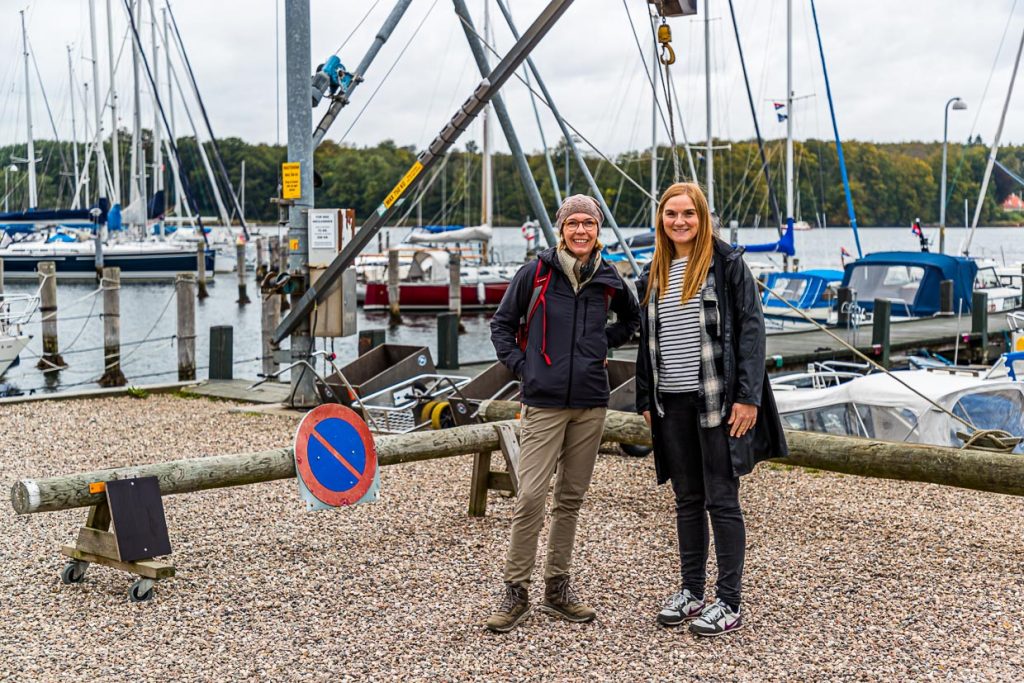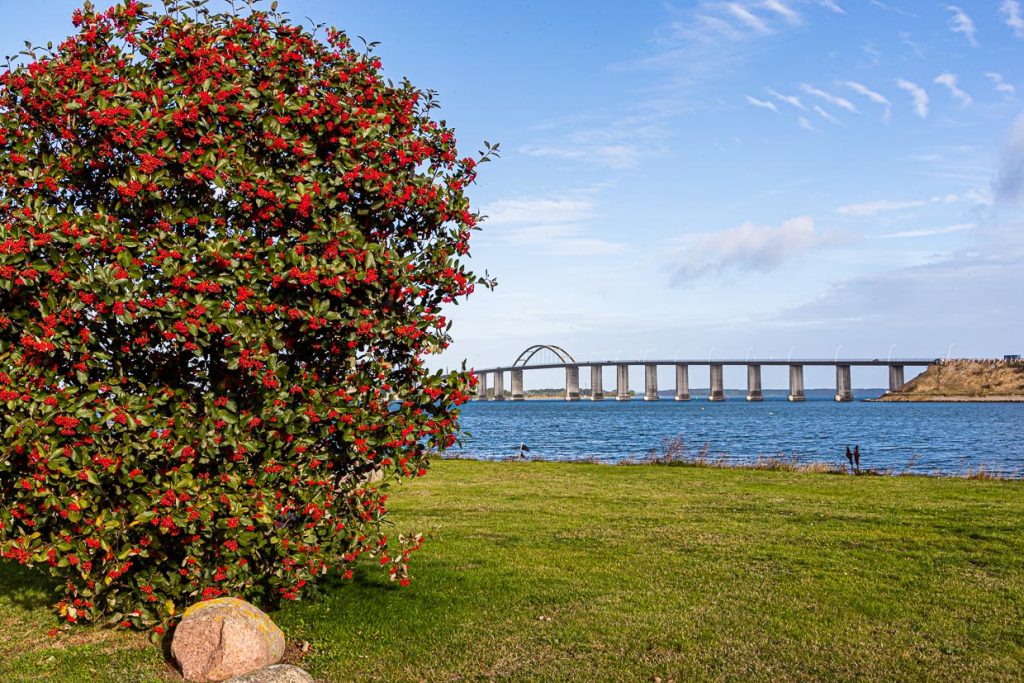On the trail of the island seas
It’s all about total relaxation as I sit in the Archipellago Museum in Faaborg with headset and probes on my earlobes and forehead. With the gentle sound of the sea on my ears and trained in relaxation through 15 years of yoga practice, it should be easy for me to let go of all thoughts. Because only if I succeeded, the red colored brain hemispheres on the display would turn into deeply relaxed blue. Unfortunately, the blue miracle failed to materialize. The experimental setup in the new Museum of Inner and Outer Landscapes seemed to be defective. Fortunately, however, nature is completely intact on the Danish island of Funen. We experience peace and relaxation as an impulse of nature a little later on a hike of several days through the South Fyn Archipelago.


Traces of the last ice age
Geologically speaking, the Danish South Sea is a flooded ice age landscape. At the end of the last ice age, the land was drowned by a dramatic rise of the sea. What remained were islands and small islets, which today can be reached by bridges, ferries or on foot at low tide. The special landscape of Funen, Denmark’s second largest island and its neighboring islands, is immediately striking. One expects flat marshland, but is surprised by a gentle hilly landscape in which water and pastures alternate with fields and forests.

From Funen via Tasinge to Langeland
The hiking trail of the archipelago has a total length of 220 kilometers. In three days we hike a section of about 70 kilometers from Troense over the bridge to Rudköbing on Langeland. From there we continue to Tranekær. The most beautiful section awaits us on day three. We take the bus from Tranekær to Lohals and hike a good 15 kilometers on a varied path directly along the sea back to the starting point. It is possible to book a luggage service for a multi-day hike. The tour provider Vagabond Tours, with its own office on the islands, offers pre-planned tours. Then one is provided with maps and luggage transport as well as a booking service for accommodations. When hiking on the smaller and lonelier islands, booking accommodation is highly recommended, as the number of hotels and B&B’s is not very large.

The shipping village of Troense
Troense was laid out in its present form in the 18th century. Old half-timbered houses, many of which have thatched roofs, characterize the village. Troense was a hub for shipping and overseas trade, and even for the training of shipbuilders. The second economic mainstay of the time was fruit growing. Fruit trees were planted around all the houses in Troense.

Loppemarked – flea markets by the wayside
Already on Funen we noticed the many house flea markets. Entire closets are moved to the street and are supposed to encourage spontaneous purchases. Payment is made on a basis of trust. Prices are quoted and the money can be put in a tin box. There are also flea tables along the roadside on our walking route.

South of Troense begins Norreskoven, a forest with very old trees. A particularly imposing specimen awaits at the end of the forest. The 500 year old Ambrosius oak. It takes its name from the poet Ambrosius Stub, house poet at Valdemar Castle in the 18th century. Ambrosius loved to read under the oak tree.

Shortly before we reach the first bridge to the small intermediate island of Siø on the first day of the hike, we have to make ourselves and the camera rainproof. The first autumn storm depression picks up speed and the rain starts. So we hike with tight step over bridges and the islet. Siø was dammed up in the 19th century in order to use more area as pasture land. So there is not much to explore here. From Siø, we head up to the second bridge, at the end of which is Langeland Island’s only town.


Rudkøbing – the only town on Langeland
By the end of September, Rudkøbing is already in the tranquil low season. In the summer a popular day trip destination with small stores and cafes, is now quiet. The most famous son of the town is the physicist Hans-Christian Örsted. He was born in 1777 in the old pharmacy on Gänsemarkt. Today, a statue commemorates him there.

Fast Internet and snow-white churches
On the second day of the hike, we leave Rudkøbing for the north. From here on it becomes rural. The path first leads along the sound and then quickly turns towards the center of the island. No village on Langeland is more than five kilometers from the sea. Fields, forest sections and farmsteads alternate. The village of Tullebölle is where we stop for a break. As sleepy as it may look here, admiration and envy also arise. Everywhere in the village, men dressed in orange are in the process of laying orange cables in the earth. Even the furthest farm is currently being connected to the fiber optic network. Hallelujah, reasonably impressed, we settle down on a bench by the beautiful white village church.

From Tullebölle, we head toward the Baltic Sea. 25,000 ships pass through the deep-water route every year. The big ferries from Kiel to Oslo can be watched here as well as the big cargo ships on their way from the Baltic Sea to the oceans.

Tranekær – Castle-town on two coasts
From Tranekær it is only three kilometers to both coasts. So friends of the sun can watch the sun rise over Lolland as well as celebrate the sunset over Funen and Tasinge. The all-dominating building in Tranekær is the castle, which glows fiery red in the evening sun.

Its most famous inhabitant in the early 19th century was Frederick Ahlefeldt-Laurvig. He was a major-general in the army, and this fitted well with his role as a fief at Tranekær Castle. He was called only the General by the islanders. The General developed Tranekær into the small capital of the county, which at times rivaled Rudkøbing. He had a school and a theater built. Foreign craftsmen were allowed to settle. A doctor and also a chapel master were employed.

Tranekær Castle is now privately owned and not open to the public. But in the horse stable of the castle is the restaurant Generalen with regional cuisine. Guests sit in the wrought-iron horse stalls. There is even an overnight accommodation in the former chicken house of the castle. The Honsehuset is a bed and breakfast.

The route from Lohals to Tranekær is uniquely beautiful, because you walk along the coast almost all the time. You are accompanied by the sound of the sea. Often you can’t see the sea at all, because high hedges bent by the wind form a hollow way.

In September, bush roses are still blooming in pink and red, and the thick fruits of the potato rose are competing with the rose hips.

There are stretches where fields extend all the way to the coast, and as you hike you flush out partridges that are dusting and sunbathing in small field hollows. Flocks of birds sit in the dense bushes of sloes, blackberries and rose hips, and deer come right up to the beach to feed. The landscapes change here in short intervals. For a short stretch, you’re in a forest of giant beech trees. They stand in the grass like gray elephant legs. The sea is always in sight.

On the way, you sometimes come across traces of a disappeared brickyard. This is because to the west of Eggeloke, the clayey loam was processed into bricks directly on the coast. It was swallowed up by the sea a long time ago. But brick remains can be found here to this day.


Most of the way from Lohals to Tranekær is like walking on a carpet over meadows, sand and forest paths. This is very easy on the joints. But even more important is the relaxation factor, because the eternal sound of the sea and the varied nature through which I am luafing almost without effort, put me in a state of total relaxation during the course of this hike. The blue miracle, which was still missing in the museum in Faaborg, the nature of the South Fyn island sea brings it about.
Travel tips:
The Danish tour planner Vagabond Tours offers walking tours for Danes throughout Europe. But also tours in Denmark, including the tour through the South Fyn Archipelago described here. The website is unfortunately only in Danish, but the staff speaks English when contacted.
To get in the mood for a hike on Fyn or the surrounding islands of Aero or Langeland, a visit to the new Archipellago Museum in Faaborg, in the south of Fyn, is highly recommended. Again, the website is only in Danish. However, the audio guides in the museum are available in English.
A good general overview for planning a trip to the Danish island of Fyn is provided by the website VisitFyn. Übersicht sortiert nach Outdoor-Aktiviäten, Städtetrip nach Odense oder Kuliniarisches and this time also everything in German.
The research trip was partly supported on site by the Fyn Tourist Board.

